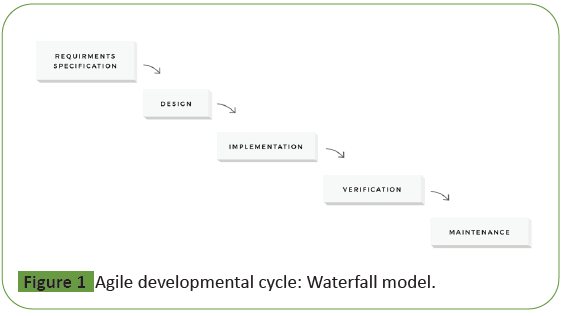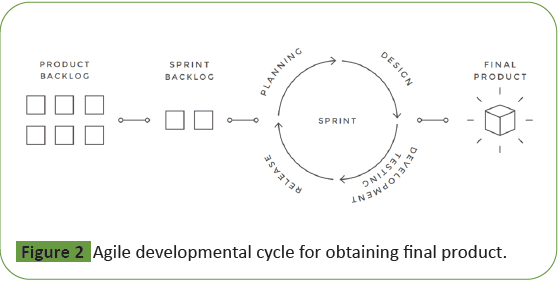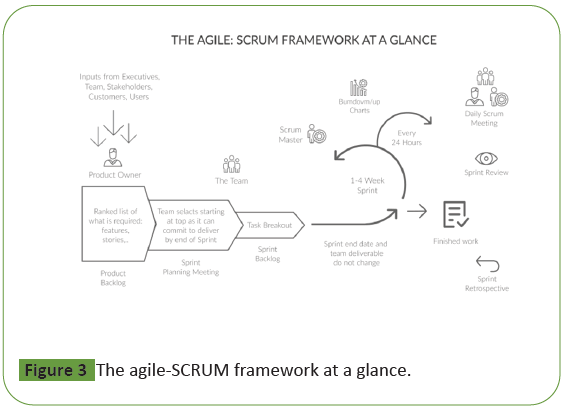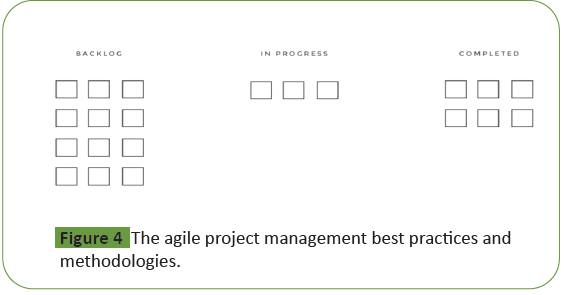Keywords
Software businesses; Programming; Testing; Monitoring
Introduction
Agile team members should be taught to understand and
manage productivity factors on a regular basis because they are
self-managed. The primary aim, according to the agile manifesto,
is to satisfy the client by delivering valuable software early and
frequently. Working software should be delivered between a
couple of weeks to a couple of months, which thus demonstrates
a project‘s progress. The agile manifesto defined the criteria
of software productivity and customer satisfaction by short
iterations and deliverables. As a result, examining agile team
productivity is critical for success in agile software development;
nevertheless, there are various other elements at play, and their
impact on agile teams must still be extensively and efficiently
investigated. As a result, examining agile team productivity is
critical for success in agile software development; nevertheless,
there are various other elements at play, and their impact on
agile teams must still be extensively and efficiently investigated.
• The art of project management
• Project management phases
Literature Review
The art of project management
Project management, as defined by some authors, is "the
application of knowledge, skills, tools, and techniques to project
activities in order to meet project requirements"1. As an integral
part of software engineering processes, project management,
along with business analysis and requirement specification,
design, programming, and testing, has been a source of
considerable debate for years. According to survey results from
the Project Management Institute (PMI), even as business project
management procedures evolve, only approximately half of them
(54 percent) are fully aware of the necessity and usefulness of these practices. Project management has proven to be a critical
component of a company's efficiency and eventual success,
regardless of industry. Firms that use proven project management
strategies squander 28 percent less money and have 2.5 times
more successful projects. According to project management
experts, a successful project is one that is not only completed
on time and under budget, but also provides the anticipated
advantages [1].
Project management phases: Any project, regardless of its scope,
should follow a set of steps that can be controlled and managed.
A typical project management process, according to the Project
Management Institute, contains the following phases:
• Initiation
• Planning
• Execution
• Performance/Monitoring
• The project has come to an end.
These phases describe the project management lifecycle and
serve as a roadmap for completing certain tasks. However, this
structure is far too broad. Within each phase of a project, there
are generally several internal stages. Depending on the scope of
work, the team, the industry, and the project itself, they can vary
significantly. Humanity has produced a large variety of project
management approaches and methodologies to discover a
universal approach to project management [2].
Traditional project management methodologies
Traditional techniques follow the above-described classic
structure and adopt a step-by-step approach to project
execution. As a result, the project proceeds in stages from start
to finish, including planning, implementation, and monitoring.
This strategy, which is also known as linear, consists of a series
of internal phases that are consecutive and carried out in a
chronological order. Traditional project management, which
is most typically used in the construction or manufacturing
industries when little or no adjustments are necessary at every
stage, has also found applicability in software engineering. The
waterfall model, often known as the waterfall process, has been
a popular software development paradigm since the early 1970s.
Waterfall model: The waterfall paradigm places a heavy
emphasis on planning and specification development, which can
account for up to 40% of the project's time and budget. A precise
sequencing of project phases is another fundamental principle
of this approach. A new stage of a project does not begin until
the preceding one has been completed. The strategy works
effectively for projects with a clear scope, a single deliverable,
and a set timeframe. The waterfall method necessitates
meticulous planning, substantial project documentation, and
close monitoring of the development process. This should,
in principle, produce in on-time, on-budget delivery, reduced
project risks, and predictable final outcomes. However, due to
the multiple constraints, the waterfall method is sluggish, costly,
and inflexible when applied to the actual software engineering
process. In many circumstances, the company's inability to adapt
the product to changing market demands leads to a massive
waste of resources and eventual project failure (Figure 1).
Figure 1: Agile developmental cycle: Waterfall model.
Why do we need agile methodology?
We had the Waterfall model of software development before
Agile came around. The waterfall model is a top-down approach
to the creation of a system or software that follows a sequential
process. This was an easy-to-understand and linear model.
Requirements gathering, software design, implementation,
testing, deployment, and maintenance were all aspects of the
waterfall methodology.
This methodology, however, had a few flaws, including the following:
• It was too time-consuming. You cannot move on to the next step unless you finish the previous one.
• This methodology was only appropriate for projects with
consistent requirements.
• The working software is supplied only after the model's final
stage has been completed.
• It is tough to go back to earlier phases and make modifications
that you hadn't considered during the initial phase.
Agile project management methodology
In contrast to established techniques, the agile methodology
was developed to make software engineering more flexible and
efficient. Agile project management has become a standard
in project management, with 94 percent of firms using it in
2015. The history of agile may be traced back to 1957, when
IBM and Motorola were developing software using incremental
development approaches (now known as Agile). Despite not
knowing how to categorize the technique they were using,
they all agreed that it was distinct from the Waterfall in several
ways [3]. However, when a group of 17 software development
professionals met in 2001 to examine alternate project
management approaches, the modern-day agile methodology
was officially established. They set out the flexible, lightweight,
and team-oriented software development strategy in the
Manifesto for Agile Software Development, which they had a clear
vision of. The Manifesto clearly explains the core ideas of the new
approach, with the goal of "discovering better ways of producing
software." The philosophy has become a ubiquitous and efficient
new way to manage projects, especially when combined with the
Twelve Principles of Agile Software. When it comes to software
development, agile techniques adopt an iterative approach.
Agile projects, unlike a traditional linear waterfall model, are
made up of a series of smaller cycles called sprints. Each one is a
mini project with a backlog and stages for design, development,
testing, and deployment within a pre-determined scope of work
[4].
Agile development cycle: A potentially shippable product
increment is given at the end of each Sprint. As a result, new
features are added to the product with each iteration, resulting in
progressive project expansion. The risks of producing a possibly
failing product are considerably reduced when features are evaluated early in the development process (Figure 2).
Figure 2: Agile developmental cycle for obtaining final product.
The main agile aspects
Flexibility: As new requirements arise; the scope of work may
alter.
Work breakdown: The project is broken down into small cycles
(known as Sprints in Scrum).
Teamwork is important: Team members collaborate closely and
have a clear understanding of their roles.
Iterative improvements: The work done during a cycle is
frequently reassessed to improve the final output.
Collaboration with a client: A client is actively involved in the
development process and can amend requirements or accept the
team's recommendations.
The Agile Manifesto's four values are as follows:
• Individuals and Interactions vs. Tools and Processes.
• Working software trumps thorough documentation.
• Customer collaboration trumps contract negotiations.
• Adapting to Change trumps sticking to a plan.
12 principles that are mentioned in the agile
manifesto are as follows:
1. Customer satisfaction through timely and consistent supply of
useful software.
2. be open to altering needs, especially late in the development
process.
3. Consistently provide working software (weeks rather than
months).
4. Businesspeople and developers work together daily.
5. Projects are created on the backs of motivated people who can
be trusted.
6. The best method of communication is a face-to-face interaction
(co-location).
7. The ability to maintain a continuous pace of development is
the most important indicator of progress.
8. Consistent development, i.e., development that can keep up
with the pace of the rest of the world.
9. Maintaining a constant focus on technical excellence and good
design.
10. Simplicity is crucial—the art of minimizing the amount of
effort that is not done.
11. Self-organizing teams produce the best architectures, needs,
and designs.
12. The team considers ways to improve its effectiveness on a
regular basis and adjusts as needed.
Agile methodology benefits:
The following are some of the benefits of agile methodology:
• The software delivery is persistent in Agile.
• Working feature(s) are given to the customer at the end of each
Sprint. They will be more satisfied because of this.
• Customers can examine the produced features to see if they
meet their requirements.
• If customers have any input or request adjustments to the
features, these can be addressed in the current or possibly next
product version.
• Even in the last stages of product development, changes might
be made.
• In Agile, product development and businesspeople connect
daily.
• The product's design receives a lot of consideration.
Agile frameworks
Agile refers to a wide range of frameworks and methodologies
that share the above-mentioned ideas and ideals. Each one has its
own set of applications and distinguishing characteristics. Scrum,
Kanban, Hybrid, Lean, Bimodal, and XP are the most prominent
frameworks.
The three agile frameworks will be discussed in this topic: Scrum is the most popular agile framework. It is utilized entirely
by 58 percent of businesses, while another 18 percent use it in
conjunction with other methods. The New Product Development
Game was first described in 1986 and formulated over a decade
later [4]. The presentation was based on what they learned while
using the strategy over the preceding few years. While Scrum
predates the Agile Manifesto, it is based on agile concepts and
adheres to the values set forth in that declaration [5].
Scrum aims to maintain good collaboration between individuals
working on complicated projects, and it is constantly changing
and adding details. It is founded on the methodical interactions
of three key roles: Scrum Master, Product Owner, and Team.
A project's scrum: Master is a pivotal player. His primary role is
to remove any hurdles that may obstruct the team's ability to
function effectively.
The product owner: who is usually a customer or other
stakeholder, is actively involved throughout the project,
communicating the product's overall vision and providing timely
feedback on the job done after each Sprint.
The scrum team: is a cross-functional and self-organizing group
of people who are in charge of product implementation. To
remain flexible and productive, it should include up to seven
team members (Figure 3).
Figure 3: The agile-SCRUM framework at a glance.
Sprints and artifacts
A sprint, or fundamental unit of work in scrum, is a short
development cycle required to produce shippable product
iteration. A sprint lasts anything from one to four weeks: Longer
iterations lack the consistency and flexibility that are key to
Scrum's success. Even though there is no standard time (if it is
less than four weeks), all sprints within a project should be the
same length. This makes planning and tracking progress much
easy. The Product Backlog, the Sprint Backlog, and the Sprint Burn
down Chart are the three key artifacts used by Scrum to manage
requirements and track progress. A variety of recurrent meetings,
such as the Daily Scrum (Standup), Sprint Planning, Review, and
Retrospective sessions, help to codify the process.
The product backlog: is a prioritized list of feature requests for
the project's final product. It is a single point of contact for all
requirements. As new needs, fixes, features, and details are
amended or added, the product Backlog is updated.
The sprint backlog: is a list of tasks that must be completed by
the team to deliver a working increment of software at the end of
each Sprint. To put it another way, team members agree on which
product items to deliver and how they will do it.
The sprint burn down: Chart depicts the amount of work that
remains in a Sprint. It benefits both the team and the Scrum
Master because it indicates daily progress and may predict
whether the Sprint target will be met on time.
Scrum meetings
A variety of recurrent meetings, such as the Daily Scrum
(Standup), Sprint Planning, Review, and Retrospective sessions,
help to codify the process (the Sprint Retrospective) [6].
The daily scrum: is a timed meeting in which a Development Team
coordinates its work and establishes a plan for the following 24
hours. The event should last 15 minutes and be held every day at
the same time and place.
At Sprint Planning, the work that needs to be done is planned. This
event is attended by everyone involved in the Sprint (a Product
Owner, a Scrum Master, and a Development Team). They provide answers to two important questions: what work can be done and
how it will be done. For a one-month Sprint, Sprint Planning takes
no more than eight hours. The meeting usually takes less time
for shorter Sprints. At Sprint Planning; the work that needs to be
done is planned. This event is attended by everyone involved in
the Sprint (a Product Owner, a Scrum Master, and a Development
Team). They provide answers to two important questions: what
work can be done and how it will be done. For a one-month
Sprint, Sprint Planning takes no more than eight hours. The
meeting usually takes less time for shorter Sprints. The team and
the product owner meet at the Sprint Review at the end of each
Sprint. The team displays completed work and answers questions
regarding the product increment during this casual discussion. All
the participants work together to figure out what they should do
next to improve the product's value. For one-month Sprints, the
Sprint Review is a four-hour time-boxed meeting. Retrospective
Meetings are held for the entire team to reflect on their work
during the Sprint. Participants examine what went well and what
went wrong, identify ways to improve, and devise a strategy for
putting these good changes into action. After the Review and
before the following Sprint Planning, the Sprint Retrospective is
held. For one-month Sprints, the event lasts three hours.
When to use scrum
Scrum is a good fit for long-term, complicated projects that
require stakeholder feedback, which can have a significant
impact on project requirements. Scrum may be the best option
when the exact amount of work cannot be determined, and the
release date is not set. Scrum has earned the trust of 89 percent
of Agile users by prioritizing customer needs and on-time/onbudget
delivery. As a result, the number of businesses that have
adopted this strategy is astonishing. Microsoft, IBM, Yahoo, and
Google are among the companies that have contributed to a
public spreadsheet. According to the Scrum Alliance's newest
research, Scrum has applications outside of IT. Companies in
the banking, consulting, and entertainment industries use
this technique to manage their work processes and improve
customer collaboration. Most respondents to the 2016 State of
Scrum Report (98 percent) said they would use this framework
to move forward.
Kanban: comprehensive solution to handling
work
Kanban is another popular project management framework.
Kanbanas is one of the project management frameworks used
by 43% of firms. Kanban is a simple, yet powerful, technique to
producing software products that evolved from a visual system
of cards used in Toyota manufacturing as a production control
method. Kanban, which is Japanese for "visible signal," focuses
on the visualization of workflow and prioritizes work in progress
(WIP), is restricting its scope to properly match it to the team's
capacity [5]. When a task is finished, the team can move on to the
next item in the pipeline. As a result, the development process
allows for more planning flexibility, quicker turnaround, defined
objectives, and openness (Figure 4).
Figure 4: The agile project management best practices and
methodologies.
Kanban board: In contrast to Scrum, Kanban does not require
established procedures inside the process or fixed iterations.
The workflow is visualized using a Kanban board, which is often
represented by sticky notes and whiteboards, or online platforms
such as Trello. Trello makes Kanban more automated and digital.
Because each Kanban board contains concise information about a
work item, everyone on the team understands who is accountable
for the item, what each person's responsibility is, when it is
scheduled to be completed, and so on. To give more information,
team members can post comments, send screenshots,
documents, or links. Kanban teams collaborate in a cooperative
manner. The ability to track progress allows coworkers to better
comprehend each other's contributions to the common goal,
resulting in a greater concentration on finishing the assignment
well and on time.
Lean: The notion of "just in time production" underpins this
software development strategy. The goal of Lean software
development is to speed up the process while lowering costs.
Lean development: Remove unneeded items (anything that
does not add value to the customer's project is removed),
development of high quality (producing high quality in
development necessitates discipline and management of the
quantity of residuals produced), create Knowledge (the team is
encouraged to document the entire infrastructure in order to
preserve its value in the future), differentiated commitments
(this point encourages the team to focus less on planning and
anticipating ideas without first having a thorough understanding of the business's requirements), fast delivery (as soon as feasible,
deliver value to the consumer), respecting the team (two key
criteria are communicating and managing disagreements),
optimize the entire process (the development sequence must
be perfected enough to be able to delete errors in the code, to
create a flow of true value).
Conclusion
Because software engineering is such a fast-paced industry, it
necessitates flexibility and reactivity in all aspects of project
development. Agile frameworks enable the delivery of cuttingedge
products and the cultivation of creative experiences while
maintaining product alignment with market trends and customer
requirements. The efficiency of agile software development
teams is critical to the success of any software project. An agile
team is made up of numerous components, all of which are
linked to human input when it comes to software development.
These elements of agile teams are garnering greater attention
in the context of productivity, and hence warrant additional
investigation.
References
- Fatema I, Sakib K (2018) Using Qualitative System Dynamics in the Development of an Agile Teamwork Productivity Model. Adv Eng Softw 11:170-85.
- Melo C, Kon F, Conradi R, Cruzes D (2014) Productivity of agile teams: an empirical evaluation of factors and monitoring processes. SBC 4: 25-30.
- Ambler S (2012) Roles on Agile teams: From small to large teams. Ambysoft 22: 11-12.
- Asproni G (2004) Motivation, teamwork, and agile development. Agile Times 4:8-15.
- Moe NB, Dingsøyr T, Dybå T (2010) A teamwork model for understanding an agile team: A case study of a Scrum project. Information and Software Technology 52: 480-91.
- McCormick M (2012) Waterfall vs. Agile methodology. MPCS 3:1-5.





